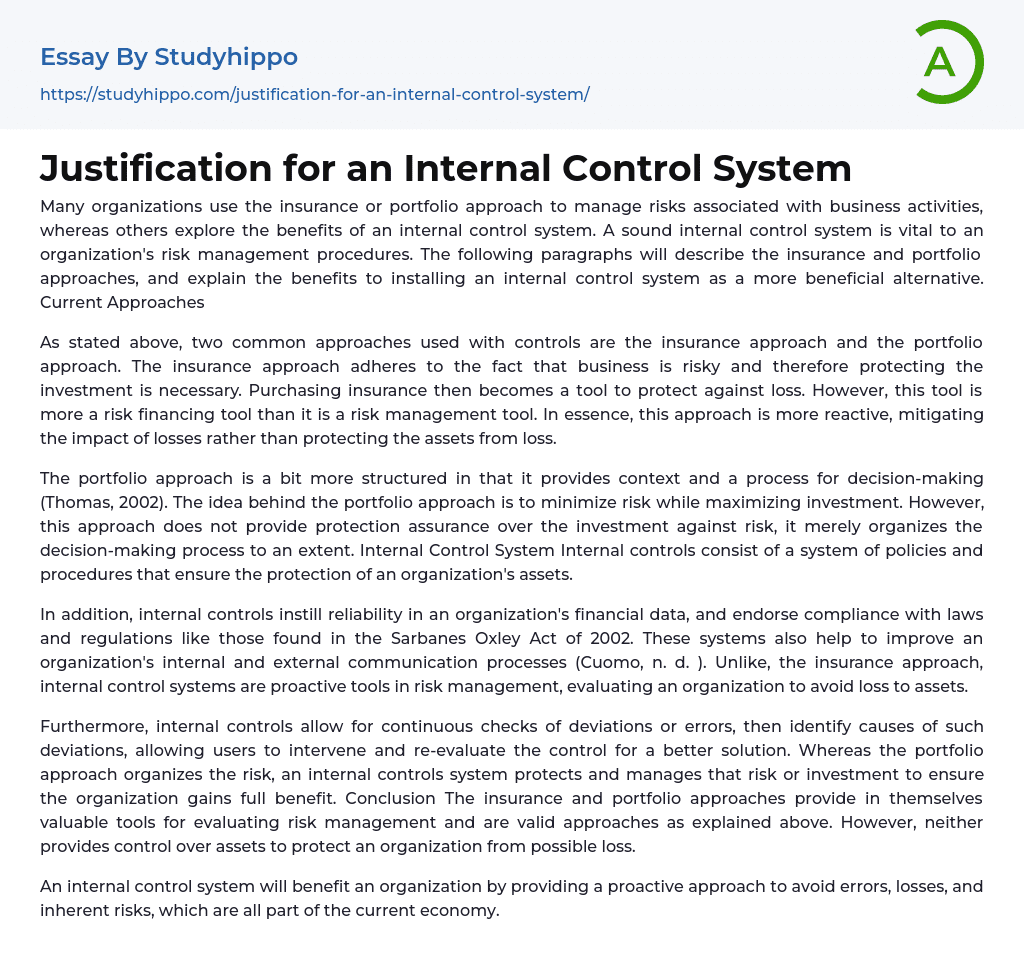

Justification for an Internal Control System Essay Example
Many organizations utilize either the insurance or portfolio approach to risk management in their business activities. However, some organizations recognize the advantages of implementing an internal control system, which is crucial for effective risk management procedures. The upcoming paragraphs will outline the insurance and portfolio approaches and underscore the benefits of adopting an internal control system as a more advantageous option.
There are two common approaches used with controls: the insurance approach and the portfolio approach. The insurance approach acknowledges the risk of business and highlights the importance of protecting investments. It considers purchasing insurance as a way to safeguard against loss. However, it is crucial to understand that insurance primarily functions as a tool for financing risks rather than managing them. In essence, this approach is more reactive, concentrating on reducing the impact of losses instead of proactively protecti
...ng assets from loss.
The portfolio approach, according to Thomas (2002), offers a structured method that aids decision-making by providing context and a process. Its goal is to maximize investment while minimizing risk. However, this approach does not guarantee protection against risk; it only helps organize the decision-making process. An internal control system comprises policies and procedures implemented to safeguard an organization's assets.
Internal controls not only ensure reliability in an organization's financial data and compliance with laws and regulations such as the Sarbanes Oxley Act of 2002, but also enhance internal and external communication processes (Cuomo, n. d.). Unlike the insurance approach, internal control systems are proactive in risk management, assessing an organization to prevent asset loss.
Furthermore, internal controls enable continuous checks of deviations or errors and identify their causes, allowing users to
intervene and re-evaluate the control for a better solution. In contrast, the portfolio approach organizes the risk, while an internal controls system protects and manages that risk or investment to ensure the organization gains full benefit. In conclusion, both the insurance and portfolio approaches are valuable tools for evaluating risk management and are valid approaches as explained above. However, neither provides control over assets to protect an organization from potential loss.
Implementing an internal control system offers organizations a proactive approach to safeguard against errors, losses, and inherent risks prevalent in the current economy.
- Aviation essays
- Emergency Management essays
- Health Insurance essays
- Insurance essays
- Life Insurance essays
- Public Transport essays
- Transportation essays
- Activity essays
- Believe essays
- Comfort Zone essays
- Dance essays
- Fashion essays
- Fishing essays
- Fitness essays
- Freedom essays
- Habits essays
- Healthy Lifestyle essays
- Hobby essays
- Hunting essays
- Interests essays
- Justification essays
- Moment essays
- Optimism essays
- Peace essays
- Perfume essays
- Shoes essays
- Shopping essays
- Silence essays
- Superstition essays
- Survival essays
- Vegetarianism essays
- Welfare essays
- Worldview essays
- Board Of Directors essays
- Brand Management essays
- Business Ethics essays
- Business Management essays
- Change Management essays
- Comparative Analysis essays
- Decision Making essays
- Dispute Resolution essays
- Knowledge Management essays
- Leadership essays
- Leadership and Management essays
- Manager essays
- Operations Management essays
- Performance Management essays
- Product Management essays
- Project Management essays
- Quality Management essays



